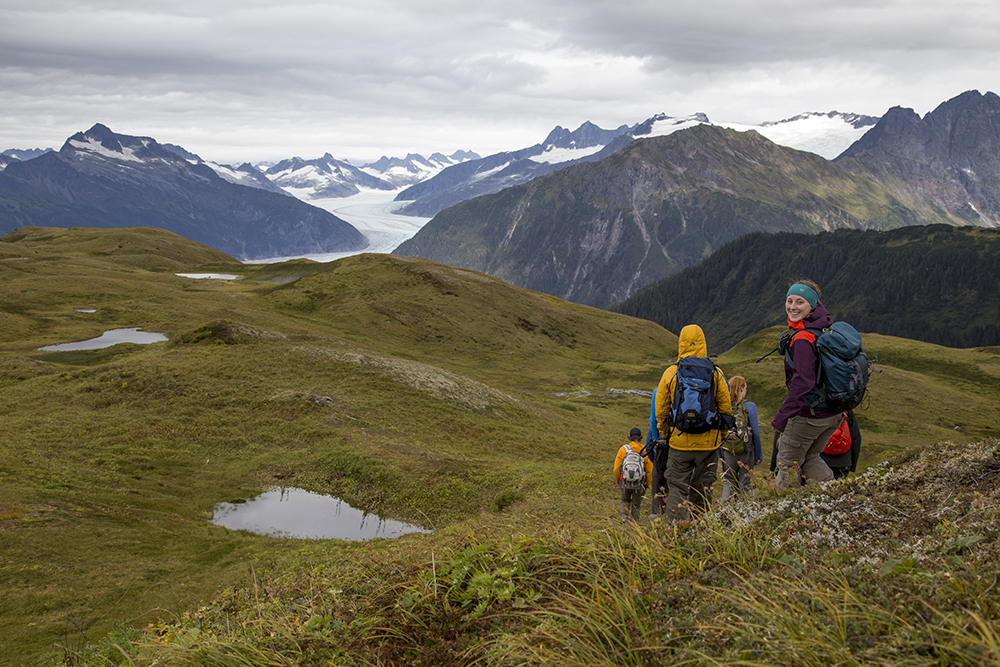
- Details
- By The University of Alaska Southeast
There’s a mythic quality to Alaska—most people picture the enormous size, the vast wilderness, and the extreme climate. However, the truth is that, in Southeast Alaska, the communities are close-knit, the land provides many resources, and people have lived here for thousands of years. In addition, it has a fairly moderate maritime climate and the sun still comes up, even on winter solstice!
The University of Alaska Southeast (UAS) in Alaska’s capital city of Juneau is part of the University of Alaska state system, yet in intimacy and character is more like a small liberal arts college. Many programs are deeply influenced by our proximity to the forest, mountains, glaciers, and ocean. Marine biology, environmental science/studies, outdoor studies, and Northwest Coast arts, languages, and studies are among our programs that most appeal to adventurous students. Hands-on learning and undergraduate research opportunities form the basis for a new career or continuing on to graduate school.
For students who are interested in multiple interests and disciplines, the Bachelor of Arts in Social Sciences combines a primary field and two secondary fields. The interdisciplinary Bachelor of Liberal Arts is our most flexible degree, and even includes student-designed degree options.
UAS offers WUE tuition rates (a lower tuition rate offered to select states in the western U.S.), many grants and scholarships, and “Come Home to Alaska”, a unique in-state tuition program for Alaskan descendents.
Supportive Student Spaces
For many students, going to college is the first time they will have been away from family and friends for a prolonged length of time. All first-year students at UAS are housed in a modern on-campus residence hall with close access to classrooms, the library, dining, activities, and services. Students meet lots of new friends through campus events and orientation activities.
The Native and Rural Student Center provides a gathering place for students to connect. It welcomes all students and hosts many clubs, including the Wooch.éen (working together) leadership organization. UAS is a Safe Zone campus for LGBTQ+ students and their allies. Counseling, disability services, and health services are available to all students. The Learning Center and Writing Center provide study assistance and peer-to-peer connections to help students succeed.
A Commitment to Higher Education and the Communities and People of Alaska
The University of Alaska Southeast’s commitment to higher education for Indigenous students includes events like Community Feast, a campus-wide celebration including subsistence foods and Oratory Showcase, highlighting the languages of Southeast Alaska (the 2022 theme is Haa Ḵusteeyí Yei Ḵugux̱saneix̱; in Lingít, “Our way of life will heal people”). UAS is the recipient of multiple grants supporting Alaska Natives and American Indians in teaching, the arts, and STEM fields; specifically the areas of food security and natural resource systems. UAS holds many public events that center around issues related to identity, historical trauma, celebration, and expression; a selection is available on the UAS YouTube Channel.
University of Alaska Southeast: uas.alaska.edu
Facebook: UASAlaska
Instagram: @uasoutheast
Twitter: @uasoutheast
The University of Alaska Southeast resides on the unceded territories of the Áakʼw Ḵwáan, Taantʼá Ḵwáan, and Sheetkʼá Ḵwáan on Lingít Aaní, also known as Juneau, Ketchikan, and Sitka Alaska, adjacent to the ancestral home of the X̱aadas and Ts’msyen peoples.
Help us defend tribal sovereignty.
At Native News Online, our mission is rooted in telling the stories that strengthen sovereignty and uplift Indigenous voices — not just at year’s end, but every single day.
Because of your generosity last year, we were able to keep our reporters on the ground in tribal communities, at national gatherings and in the halls of Congress — covering the issues that matter most to Indian Country: sovereignty, culture, education, health and economic opportunity.
That support sustained us through a tough year in 2025. Now, as we look to the year ahead, we need your help right now to ensure warrior journalism remains strong — reporting that defends tribal sovereignty, amplifies Native truth, and holds power accountable.
 The stakes couldn't be higher. Your support keeps Native voices heard, Native stories told and Native sovereignty defended.
The stakes couldn't be higher. Your support keeps Native voices heard, Native stories told and Native sovereignty defended.
Stand with Warrior Journalism today.
Levi Rickert (Potawatomi), Editor & Publisher
